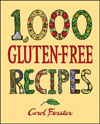Fall is here and the holidays are just around the corner, so many of us are doing more baking these days.
If eggs are not a problem at your house, you probably use them without even thinking about it. But if you have egg allergies or intolerances, baking without eggs is a real challenge. In fact, I would rather give up wheat flour than eggs when it comes to baking!
But over the years, I’ve learned how to use ingredient substitutes for eggs, so here’s a quick look at what I’ve learned. A few of my books contain recipes for baking without eggs Cooking Free and 125 Gluten-Free Vegetarian Recipes so you really need those books for the recipes and more explanation and hints because each substitute has advantages and disadvantages. But here are the highlights:
Why Are Eggs So Important?
Eggs are one of the hardest ingredients to make substitutions for because they play such critical––and varied––roles in baking. They can be used as binding agents (hold ingredients together), moisturizers (add moisture), or as leavening agents (make things rise) in baking.
And, it gets more complicated.
Egg yolks and egg whites play separate roles in baking. The lecithin in egg yolks emulsifies ingredients, that is, it blends ingredients together that would not ordinarily blend––such as oil and water––and produces smooth, creamy textures.
Egg whites, on the other hand, are the actual leavening component of eggs. They make soufflés or angel food cakes light and airy. Knowing all this, you can see why the standard “fix” in gluten-free baking is to add another egg to the recipe!
Eggs as Binders and Moisturizers
If the recipe has only one egg but contains leavening––such as baking powder or baking soda––then the egg is the binder. If there is no other liquid, then the egg is the binder AND the moisturizer.
I’ve tried several egg substitutes, but my favorite egg-free binder/moisturizer is soft silken tofu or flax seed––with puréed fruits such as applesauce, bananas, or prunes my next favorite. Tofu (soft, silken) makes baked goods moist, with an appealing, though somewhat dense texture. The natural pectins in fruits, especially prunes, trap air which helps “lighten” baked goods.
In place of 1 large egg as a binder and/or moisturizer, use:
*Soft Silken Tofu (Mori-NuÒ): Use ¼ cup and blend with recipe liquid until completely smooth before adding dry ingredients.
* Flaxseed: (available as brown or golden seeds which you pulverize in a small coffee/spice grinder first or start with ground flaxmeal): Use ¼ cup for each large egg. Combine 1 teaspoon ground flaxseed with ¼ cup boiling water. Let stand 5 minutes to thicken and cool slightly. Refrigerate flax to avoid rancidity.
*Pureed Fruits and Vegetables: (Applesauce, bananas, prunes, apricots, pears, carrots, and corn.) Use 3 Tbsp.
Increase liquid in recipe by 1 Tbsp.
Eggs as Leavening Agents
If there are no other ingredients that make the baked item rise (yeast, baking soda, baking powder), then the egg is the leavening agent. Baked goods that rely on egg whites to make them rise––such as angel food cakes or soufflés––do not work well with egg substitutes.
In place of 1 egg as a leavening agent, use:
*Egg Replacer Powder (Ener-G or Kingsmill): Whisk 1 Tbsp. into 2 Tbsp. water until smooth.
*Buttermilk-Soda: Replace liquid in recipe with same amount of buttermilk (or thinned yogurt or cultured coconut milk). Replace baking powder with one-quarter as much baking soda (e.g., ¼ teaspoon baking soda for each 1 teaspoon baking powder.)
Also, try these additional tips:
[1] Add air in two ways to make the recipe lighter and less dense:
-a. Cream fat and sugar together with electric mixer. Then add dry ingredients, or,
-b. Whip liquid ingredients in blender for 30 seconds to incorporate air into recipe.
[2] Add an extra 1/2 teaspoon baking powder per egg. Do not exceed 1 teaspoon baking powder per cup of flour or a bitter taste develops and you can over-leaven a recipe, causing it to fall.
[3] Choose recipes with acidic liquids such as buttermilk, molasses, lemon juice, or vinegar since they tend to rise better than those with non-acidic liquids such as water or milk.
One final note: Check with your physician to make sure egg substitutes are acceptable for your diet. And, you are allergic or intolerant to eggs should also avoid products such as Egg-Beaters® because they still contain eggs (usually just the whites), but possibly other food culprits, as well.








